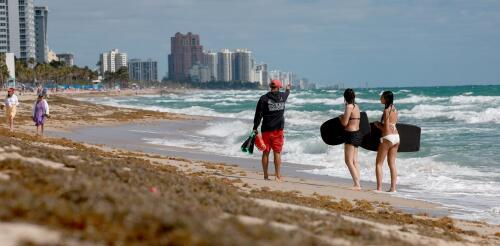Biodiversity
Spring is planting time for home gardeners, landscapers and public works agencies across the U.S. And there’s rising demand for native plants – species that are genetically adapted to the specific regions where they are used. Native plants have evolved with local climates and soil conditions. As a result, they generally require less maintenance, such as watering and fertilizing, after they become established, and they are hardier than non-native species. Many federal, state and city agencies rank native plants as a first choice for restoring areas that have been disturbed by natural disasters or human activities like mining and development. Repairing damaged landscapes is a critical strategy for slowing climate change and species loss. But there’s one big problem: There aren’t enough native seeds. This issue is so serious that it was the subject of a recent report from the National Academies of Sciences, Engineering and Medicine. The study found an u...
An unwelcome visitor is headed for Florida and the Caribbean: huge floating mats of sargassum, or free-floating brown seaweed. Nearly every year since 2011, sargassum has inundated Caribbean, Gulf of Mexico and Florida coastlines in warm months, peaking in June and July. This brown tide rots on the beach, driving away tourists, harming local fishing industries and requiring costly cleanups. According to scientists who monitor the formation of sargassum in the Atlantic Ocean, 2023 could produce the largest bloom ever recorded. That’s bad news for destinations like Miami and Fort Lauderdale that will struggle to clean their shorelines. In 2022, Miami-Dade County spent US$6 million to clear sargassum from just four popular beaches. Satellite image of sargassum concentrations in the Atlantic during the month of March. USF/NOAA, CC BY-ND Sargassum isn’t new on South Florida beaches, but its r...
Forests are critically important for slowing climate change. They remove huge quantities of carbon dioxide from the atmosphere – 30% of all fossil fuel emissions annually – and store carbon in trees and soils. Old and mature forests are especially important: They handle droughts, storms and wildfires better than young trees, and they store more carbon. In a 2022 executive order, President Joe Biden called for conserving mature and old-growth forests on federal lands. Recently Biden protected nearly half of the Tongass National Forest in Alaska from road-building and logging. The Biden administration is compiling an inventory of mature and old-growth forests on public lands that will support further conservation actions. But at the same time, federal agencies are initiating and implementing numerous logging projects in mature and old forests without accounting for how these projects will affect climate change or forest species. As scientists who have spent decades...
Human trade and transport have led to the intentional and accidental introductions of non-native species outside of their natural range globally. These biological invasions can cause extinctions, cost trillions, and spread diseases. A study from the GEOMAR Helmholtz Centre for Ocean Research Kiel, now published in Global Ecology and Biogeography, has investigated how many of these non-native species already exist worldwide and which species groups are particularly prone to become non-native. “Everything that exists can be introduced somewhere at some point,” says Dr. Elizabeta Briski. The marine biologist is an expert in invasion ecology at GEOMAR Helmholtz Centre for Ocean Research in Kiel. Along with a large international team of renowned ecologists, she has conducted a study to investigate whether non-native species mirror Earth’s patterns of biodiversity and found that greater numbers of non-native species...
A new platform allows companies and landowners to monitor the ecosystems in their supply chains, as governments around the world increasingly consider regulations that require businesses to account for biodiversity. The tool, NatureHelm, provides a subscription-based platform where large corporate entities or individual landowners can track significant species and ecosystem markers on their properties. The platform also provides analysis of how factors are changing over time and recommendations to improve biodiversity outcomes. NatureHelm plans to launch this month. “[Tracking biodiversity] is no longer something that is a nice thing; this is going to become regulated,” says Debbie Saunders, a conservation ecologist and founder of NatureHelm. “It’s quite revolutionary for me. I used to go bird-watching for my job, and all of a sudden, I feel like I can help create positive change at a global scale.” The new push toward be...



